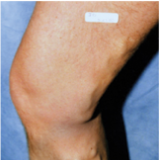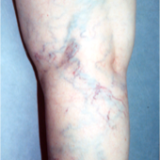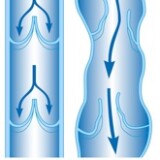Varicose Veins
WHAT IS IT?
Varicose veins are swollen, visible veins found on legs. They occur due to leaking of valves which have become incompetent.
They commonly cause many symptoms including:
HOW IS IT DIAGNOSED?
Diagnosis is based on a history and then examination of the legs. Following this patients would undergo scanning with either a hand held Doppler or a duplex scan (ultrasound of the veins) to find the reasons behind the veins. This will then allow the consultant to make a decision on the treatment.
WHY SHOULD I HAVE IT TREATED?
Patients will want treatment because they have symptoms associated with varicose veins as described above. If there are skin changes or patients have had leg ulcers then treatment of the veins may help reduce risk of leg ulcers. Some patients will want to treat their veins for cosmetic reasons.
WHEN SHOULD IT BE TREATED?
Your consultant will decide on the need for treatment after assessing your symptoms and then examining you. Treatment will also then be based on any further investigation you undergo.
CONSULTATION
This involves gathering information about your condition, any previous treatment of your veins and what your expectations are. You will also need to give information about any other medical conditions that you may be suffering from and also if you take any regular medications.
This is followed by examination of your legs including a hand held doppler tests which assess whether your valves are leaking (this is the reason for your veins).
Depending on your treatment preferences you may then be examined with an ultrasound machine (called a duplex scan) which give an image of your veins. This is important if you are planning on having laser treatment.
Once the assessment is done, the various options will be explained to you by the consultant and the costs of the each treatment will be discussed.
You can then make a choice on which treatment you would prefer.
Veins can be treated using conventional surgery or using minimally invasive techniques.
OPEN SURGERY:
This involves stripping out the affected vein as well as pulling out the visible veins. This is undertaken under general anaesthetic. There are risks of the operation which will be discussed with you by your consultant.
MINIMAL INVASIVE TREATMENT:
There are many treatment for this condition though our preference is to undertake endovenous laser treatment (EVLT). This is usually undertaken under local anaesthetic and involves putting a wire into the affected vein and blocking of the blood flow into the vein.
FOAM SCLEROTHERAPY:
This is also done under local anaesthetic and involves injecting a sclerosing agent which has been mixed with air into the affected veins. This also has slightly differing complication compared to above and this option will also be discussed with you when you see your consultant. It is also used for cosmetic veins such as thread veins.






